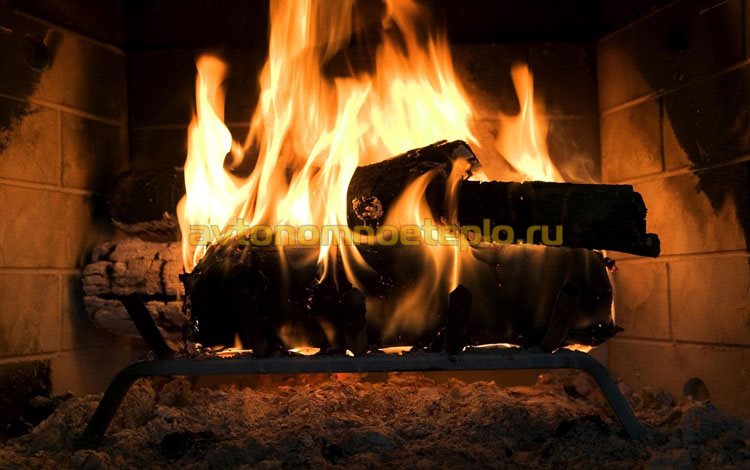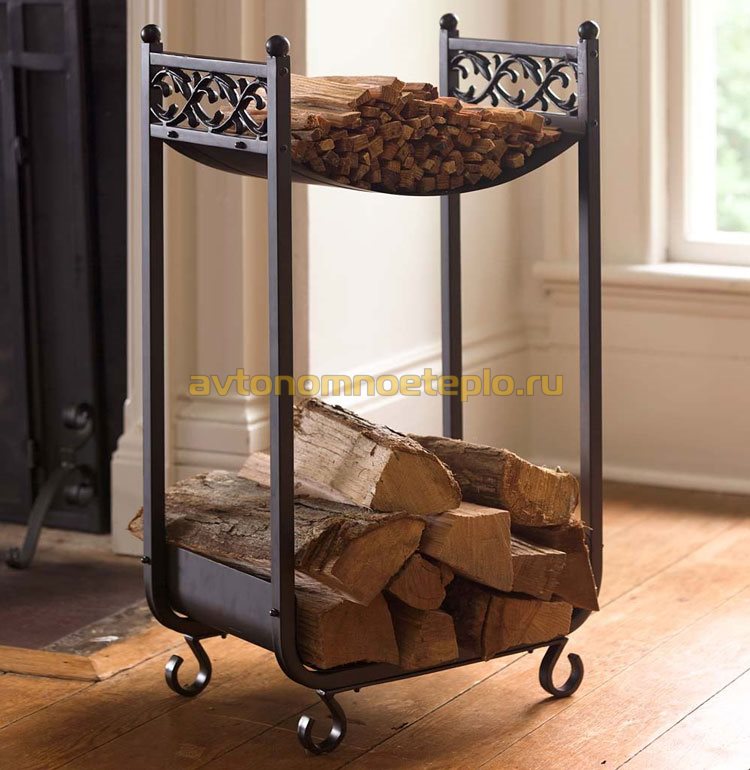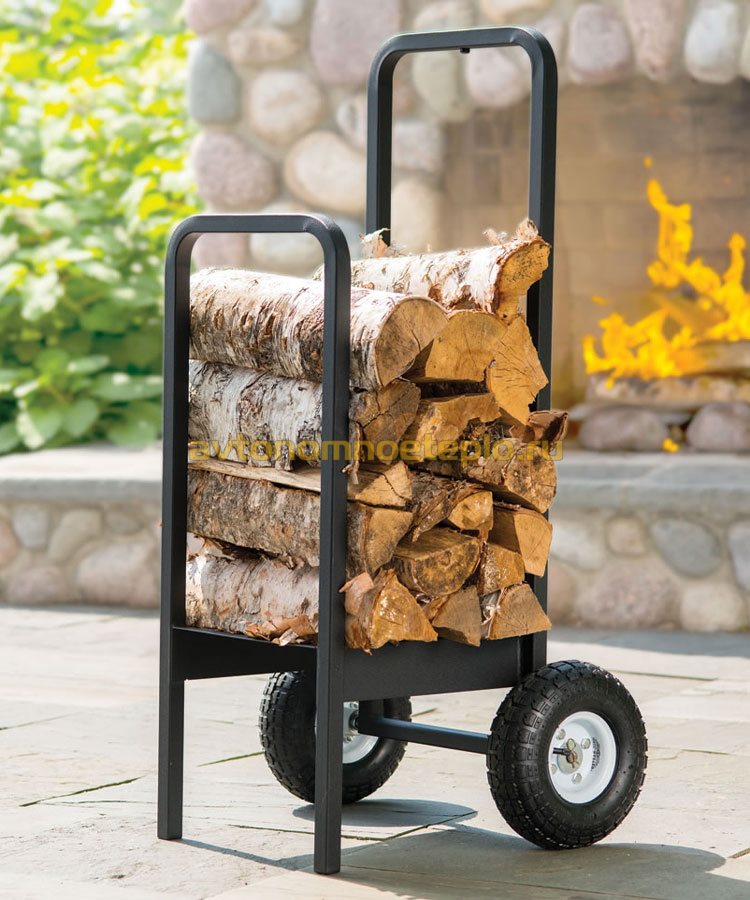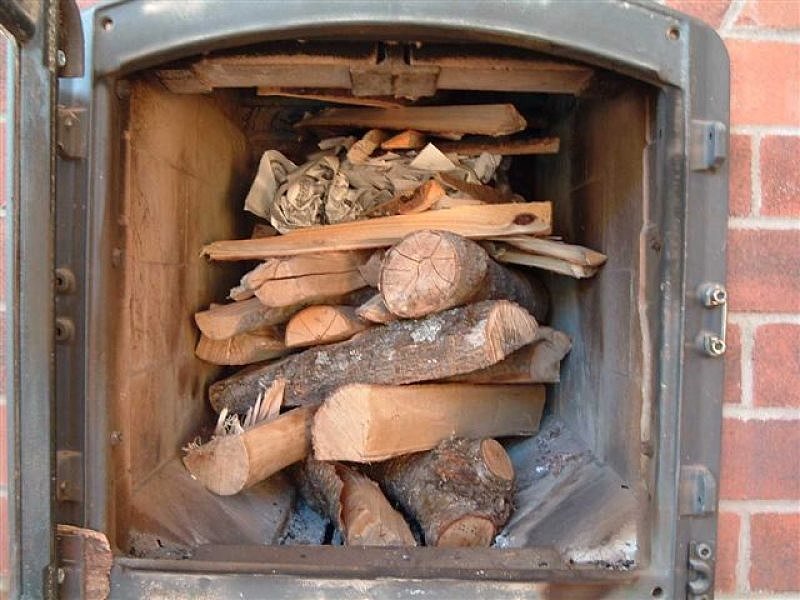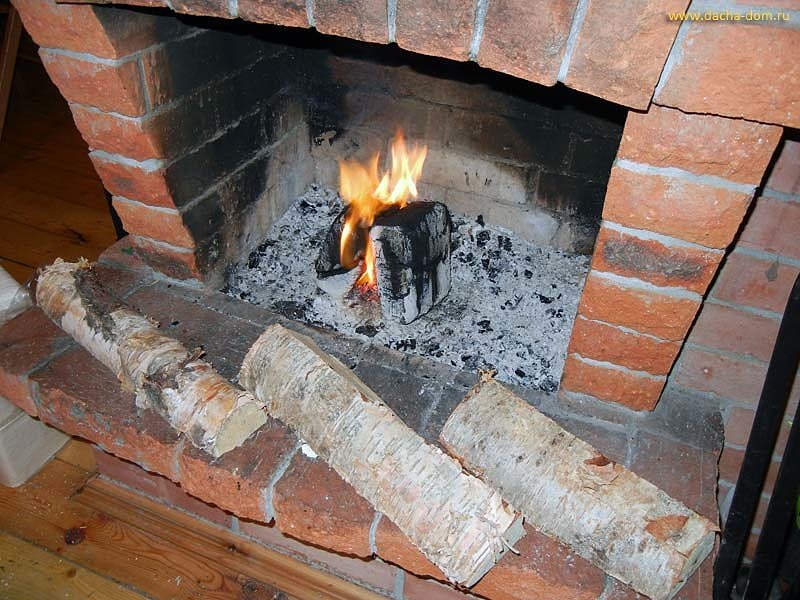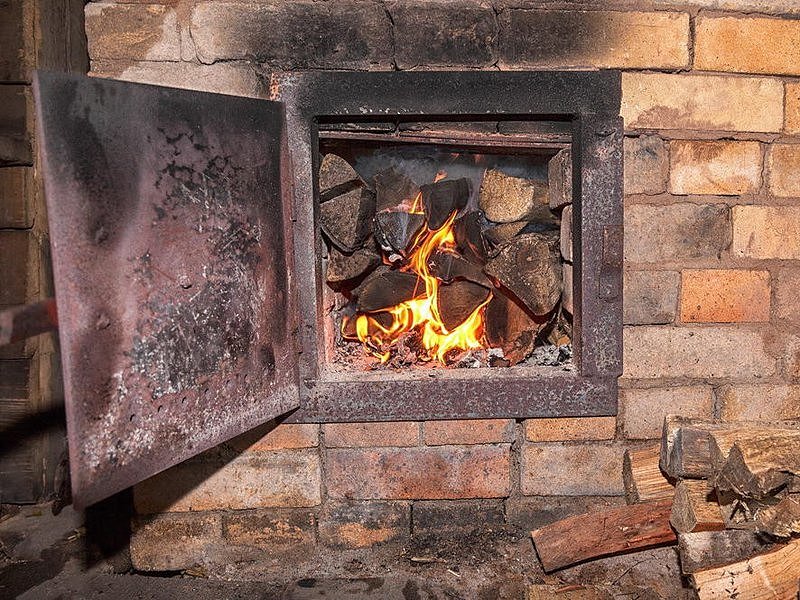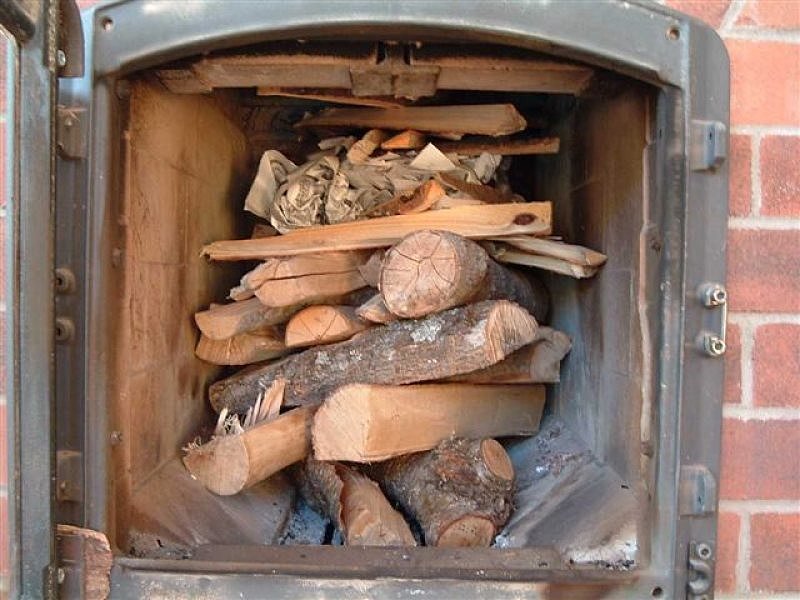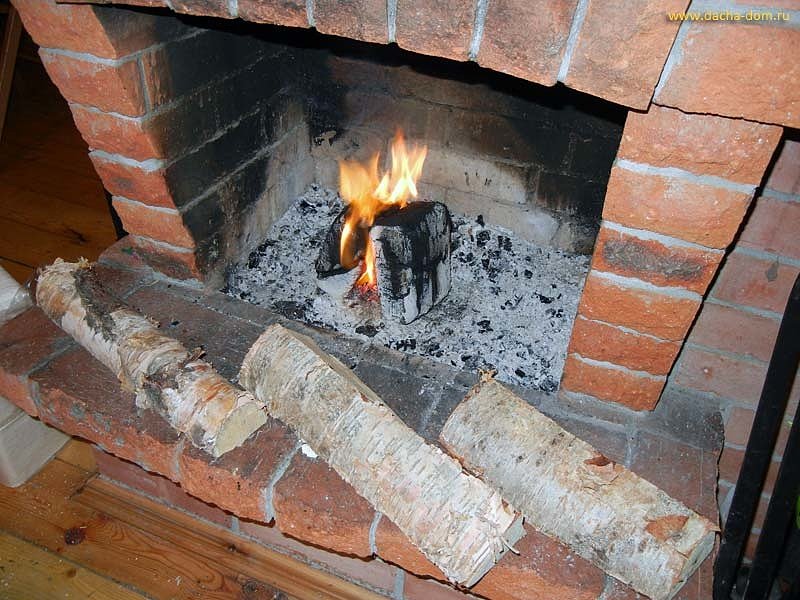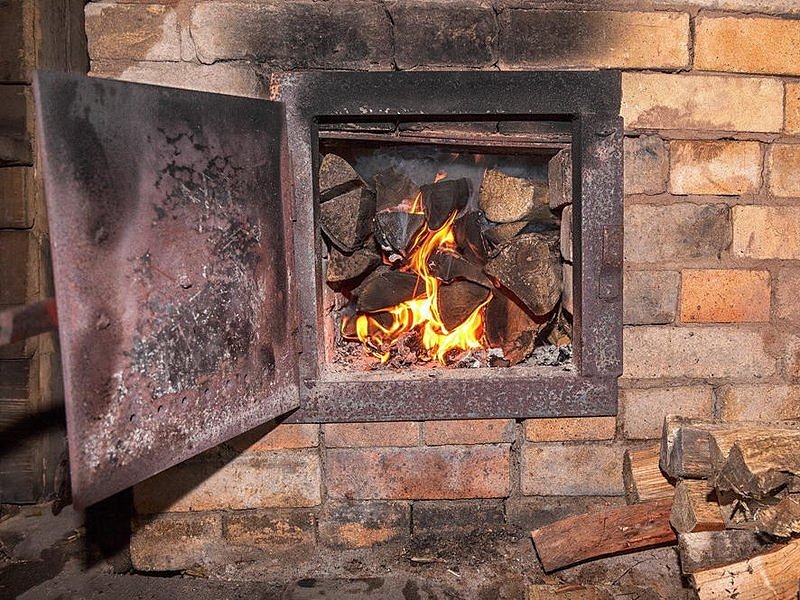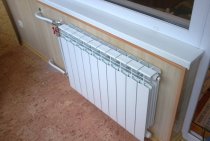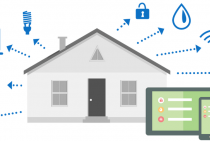A little about heat dissipation
Classic naminas with a shallow open firebox built into the wall framed by a portal are beautiful, but not functional. At a high cost, they have a significant flaw - low efficiency, the limit of which is 20%. Such fireplaces will heat only a small room, and it is impossible to influence the amount of heat they emit.
Practical owners prefer cast-iron stoves with a closed firebox to classic fireplaces, the efficiency of which reaches 80%. Two or three stacks of logs (although they can run on different fuels - peat, coal, diesel and gas) - and a fireplace with a closed firebox warms its owner all day. Power up to 25 kW allows you to heat an area of 250 m2. In this case, the strength of the flame can be adjusted using a damper. Furnaces with transparent doors (the hearth in such fireplaces is closed with heat-resistant glass) are equipped with secondary afterburning of flue gases and have an advantage in maintenance (less ash). Furnaces without cladding, painted with heat-resistant paint, are unlikely to become an interior decoration, but they are more convenient to use. Such fireboxes are mobile (they can be placed in any desired place) and easy to install (they are easily connected to the chimney). For zealous owners, fireplace stoves are also good because you can cook on them: some of the models are equipped with a small stove.
We determine the moisture content of firewood
Before putting firewood in the fireplace, hold it at room temperature for at least a day. Wet firewood sizzles and cracks when burned, releasing soot and black smoke. In addition, there is a direct dependence of calorific value on humidity.
Use free-drying wood that has been stored in a ventilated area or outdoors under a shed for at least six months, including the summer months.

A moisture meter will help you find out the moisture content of firewood. It is good when it is always at hand, because for the efficient operation of the fireplace it is necessary to have high-quality firewood, namely, with a humidity level of no more than 15%.

Logs brought in November from the street have an average of 17 - 20%. Set their wood rack aside for the next day to dry. But if you have to burn them, then it is better to put them in an already well-heated firebox at the second, and even better, at the third bookmark.
On the back of the Kratki moisture meter, the allowable wood moisture values are indicated, in addition, they are marked in yellow and green for easier perception.

Firewood that has lain indoors for about a week has ideal moisture levels: 3 - 8%, depending on the type of wood. Select them for the first kindling.

Before starting the ignition, it is necessary to open the gate (if any), and the valve for supplying air to the combustion chamber. So, let's start with the correct stacking of firewood.
How to properly heat a stove or fireplace
Having flooded the stove or fireplace, one must always remember that a warm friend can become a dangerous enemy if you do not pay due attention to him. A few simple rules will help you safely enjoy the comfort of your hearth.
Kindling and maintaining a fire in the hearth I consider an art. Of course, there is a set of rules, but there are some personal ways to control tamed fire. Everyone who does this with love begins to use their own methods, sometimes without even realizing it. For example, I always put a birch log in the fireplace with the bark down - just to see and hear a lively, cheerful, crackling flame.
Kindling
Building a fire is not rushed. If the firewood is dry, a piece of birch bark and a few thin torches are enough for the fuse. And now the fire is already frolicking merrily in the fireplace. But more often it happens that the firewood is damp, when kindled, they turn black, smoke and go out, evil blue tongues of a slightly glowing flame run through them. Such firewood does not have enough temperature for combustion.In this case, it is necessary, without haste, to make 2-3 heatings with thin torches, let them burn out and form at least a small layer of hot glowing coals. Raw firewood, laid on such coals, will begin to dry slowly and hiss slightly, and then they will take up fire. When the side of the logs lying on the coals burns and becomes grayish-white, you need to carefully turn the firewood over with a poker and distribute it in the firebox so that there is a small distance between them - about 2-3 cm. The firewood will immediately light up well.
Furnace process
When the flame in the fireplace is already stable, you do not need to throw up a lot of firewood at once. They, of course, will get busy and will burn very strongly, with noise and hum - and the flame will beat not in the fireplace portal, but in the smoke box. But, firstly, all the heat will quickly go into the chimney, and secondly, and this is the main thing, the fireplace in such a situation can be overheated. The brickwork may burst - and the furnace gases will rush into the cracks, "smoke from all the cracks." Then such a fireplace is almost impossible to repair. A friend of mine, a stove-maker, said about this: “Very often, strangers ruin a good fireplace. For example, workers doing repairs in the house can burn construction waste and even foam plastic in the fireplace. Don't trust strangers to fire your fireplace."
Finally, you have melted the fireplace - now you can sit near it, resting your body and soul, as long as you like. The flame in the fireplace should be calm, the ends of the tongues should not be higher than the top of the portal. If you have a fireplace - with doors, leaving it, cover them: the traction force can be adjusted with blowers in the lower parts of the doors.
The draft in the fireplace can also be adjusted with a valve in the pipe, but you can cover it during the furnace by no more than a quarter. When the fireplace flares up and several hours pass, the heated bricks of the firebox begin to radiate the most wonderful and useful heat that penetrates the body, warms it very softly and pleasantly. This heat can be used to treat back, joint and cold ailments - or just enjoy it on a cold winter evening.
The end of the firebox
This is a responsible process, and there are several conditions that must be met.
The main thing - do not leave even a part of the log in the fireplace, even if it is completely black, does not burn or smoke: it is dangerous! In the closed firebox of the namin, the temperature is very high, the unburned wood will almost certainly begin to smolder, and then catch fire. Having finished the furnace and closing the valve, we block the exit of furnace gases, including dangerous carbon monoxide, which gives itself out as small blue flames. Such tongues at the end of the firebox should not be at all. You can leave a small amount of small red coals by breaking them with a poker. But only if you have a simple furnace valve in the pipe, 8 of which there is a small gap for the exit of hot furnace gases. Although, of course, a large amount of heat is lost through such a valve.
There is furnace fittings - a view. This is a plate in the chimney - with a hole, overlapping with a completely round "blink" and a lid. This design allows you to save much more heat, but now it is extremely rare. However, if you have a view, do not leave even red coals in the stove or fireplace.
In the evening, finishing the firebox of my fireplace, I always close its doors with a feeling of regret and a slight sadness from parting with the fire. And I believe that tomorrow we will meet again and again we will look at each other for a long time.
Alexandra Zakharova

How to heat a fireplace with wood
The ability to properly kindle a fireplace is associated with an understanding of the features of operation and the principles of combustion. It is required to ensure the safety of people in the building, preventing the likelihood of fire and the spread of carbon monoxide into living rooms.
How to properly stack wood in a fireplace
- Preparatory work - it is better that the size of the firewood is approximately the same.Logs are selected 5 cm less than the depth of the firebox. Some manufacturers sell ready-made calibrated wood suitable for most types of fireplace hearths. Before the start of the firebox, a view opens, creating draft in the fireplace.
- The seed or kindling is laid - in fact, it is dry chips laid in a slide, so that there is a free passage of air between the splinters.
- Logs are placed on top of the seed, at a distance of 15 cm from each other. They will be the basis of the future "bonfire". Firewood is laid on them, according to the principle of a "pioneer fire".
There is a way to ensure that the fireplace does not smoke when burning wood in the hearth. The seed is transferred from the base to the top of the stacked mountain of firewood. The fire is ignited from above and gradually goes down. This method is possible only if there is good traction and dry fuel.
How to start stoking a fireplace after a long period of inactivity
-
The formation of air pockets
- draft in the chimney is formed due to the natural circulation of air when the heated gases rise up. In the place where cold and heated masses collide in the chimney, air pockets form. When the fireplace is first started, a newspaper is lit and a hand with burning paper is thrust into the chimney inside the hearth. After a few minutes, warm air will create the necessary traction. You can proceed to the main kindling. -
Freezing of the walls of the chimney
- the second problem is connected with the need to light a fireplace in an unheated room. The difficulty lies in the fact that the heating rate of the inner bowl is faster than the walls outside the hearth. If you heat the fireplace at a cold temperature in the room, without taking into account this nuance, the walls of the portal will quickly collapse. Kindling is done slowly. The fireplace insert is filled with firewood to a maximum of ⅓. The duration of the fireplace insert, until the building warms up, does not exceed 1-1.5 hours.
It is forbidden to use a flame retardant liquid to prevent rapid heating of the fireplace walls in an unheated room. As a result of extinguishing the flame, a large amount of carbon monoxide is released. Sufficient traction has not yet been restored. Carbon monoxide will enter the room, not the chimney.
How to heat a fireplace correctly so as not to burn out
You need to heat the fireplace so as not to burn out. This requires ensuring normal and stable draft and reducing the amount of smoke from burning wood. This is done as follows:
- Firewood with the optimal percentage of moisture is used
- Ignition is carried out with a gradual increase in temperature.
- It is better to use logs without bark - a source of smoke. Chopped or rounded birch firewood, ideal for the first kindling. Humidity of products is no more than 20%, there is no bark and branches.
- The fireplace and chimney are regularly cleaned. The integrity and tightness of the chimney is checked.
- With a burning flame, it is forbidden to completely close the damper that regulates the intensity of draft.
How and in what, it is better to store fireplace wood
It is better to store firewood in the room where the portal is located. It is more convenient and practical to use. Otherwise, the choice of storage depends on the taste of the owner of the house and the features of the room:
There are tables for drying firewood, which indicate the period of time required for the logs to dry, depending on the month of harvest. So, wood laid in a woodpile in July will dry for at least 310 days, and in March, only 140 days.
Fireplace maintenance is a complex process. If wood harvesting and storage are difficult, the best option would be to purchase ready-made logs that have optimal moisture content and are ready to fire.
We put firewood
The second bookmark must be done when the fire goes out. But before you fully open the door, open it slowly for a few seconds to let in some air and equalize the pressure inside and outside the fireplace.
Spread the smoldering coals evenly across the bottom of the firebox with a log or poker. Gently, without throwing, place two or three larger logs in the fireplace so that there is room between them for air circulation. Close the door tightly.

Almost a minute later, when the logs are flaring up, limit the air supply to about half. This way you will slow down the burning process, and the firewood will burn out longer.
Firewood should burn to the end and go out on its own. Do not deliberately extinguish the fire, this can lead to smoke in the room, and sometimes even cause a fire.
I want to note that lighting a fireplace and putting wood into a well-made fireplace is a rather pleasant and exciting activity. And many who have learned how to use it correctly will agree with this.
Preparation, laying and checking
Not knowing how to properly heat the stove with wood, it is important to carry out all the preparatory work, for this, buy in advance and prepare such a tool as:
- A poker of a certain length, which depends on the size and depth of the firebox;
- Scoop made of refractory and lightweight materials, such as tin. Its width should be less than the blower chamber;
- Canvas mittens, this material is characterized by high strength and optimal thickness. They are used in the process of kindling and operation of the heating unit, protect hands from burns, and allow you to touch heating structural elements.
Many believe that coal can be used as a fuel - this is true, however, contrary to popular misconceptions, it cannot be wetted, since the combustion process will be better only until the moisture has completely evaporated as a result of fire
It is important to use high-quality coal, which will be represented by lumps, and not dust, which is not suitable for kindling stoves and fireplaces.
At the second stage of the preparatory work, it is necessary to check the operation of the traction mechanism, for this, pull out the chimney damper, which is used in the warm and summer seasons. Now put your hand there and if you feel a tangible flow of wind, a draft, then the thrust is working fully and at full power, which is what we need. If you do not feel the streams of the advancing wind, you need to light a match, and then warm up the chimney channel by burning paper through the cleaning door, which is located at the bottom of the chimney.
After you have cleaned the chimney channels and the draft has normalized its correct and efficient operation, it is necessary to clean the structure of all contaminants and combustion products, in this case we will need to use a poker.
At the third stage, it is necessary to lay the fuel in the hearth, for this you can use any wood, the main requirement for it is good dryness, a minimum of moisture in the composition
In order for your firewood to fully meet all these criteria from the outset, it is important to arrange a place for storing it with a low level of humidity, preferably not on the street.
Before loading the fuel into the hearth, it is necessary to cut it into approximately identical and small logs, you can also use the remains after repair for kindling, for example, knots, shavings, brushwood, birch bark.
Kindling is carried out according to the following rules:
Stage, actions
Description
Bookmark the first layer
The kindling of solid fuel stoves must be carried out in accordance with all existing norms and requirements from the side of fire safety, since in this case there is a possibility of carbon monoxide dangerous for life and health entering the room.
The end of kindling is always planned for earlier, no later than a few hours before going to bed or leaving the house;
Before you start a fire in the hearth, you need to make sure that soot and soot are not present in the combustion chamber;
For kindling, high-quality, well-dried materials are used; in no case do not use flammable liquids;
The fuel must be suitable for the hearth, not affect it in a negative way, and not contain harmful and toxic substances;
The traction mechanism must work correctly and at full capacity, which should not be forgotten throughout the entire kindling;
At the final stage, it is important to make sure that the coals are completely burnt out.
A metal fireplace must be heated by means of small and gradual bookmarks, so that the structure does not overheat very much, the metal does not become thinner and deformed.
If you do not know how to properly heat the stove in the house, we recommend that you watch the following video:
One of the activities in all pioneer competitions was the ability to kindle a fire. Years have passed, but we remember many of the subtleties associated with this process. From the point of view of physics, for the combustion process it is necessary to provide oxygen access and remove combustion products. These two principles are implemented in any fireplace and any stove with the help of design features.
A real fireplace, regardless of its type, is based on the release of heat from the combustion of fuel. The characteristics of the fireplace, including its efficiency, are constant parameters depending on the design of the device and the material. But under all the same conditions, fireplaces can produce different amounts of heat. It turns out that it all depends on how to heat the fireplace.
We fill the house with warmth and comfort
Video
P
adhering to these rules, your fireplace will always delight with its playful and enchanting spark.
- The chimney must always be free of tar and other foreign debris;
- Use dry wood as fuel and, if possible, without tar
- When igniting, you should not throw firewood into the fireplace. when ignited, a strong emission of flames and smoke from the furnace itself can occur;
- Not heat the fireplace
birch, because due to the large amount of tar, it smokes very strongly; - When the fireplace is burning, do not create a draft in the room. Do not slam doors and windows hard;
- It is not recommended to use coniferous firewood, as they sparkle and heavily pollute the chimney with soot. Open fireplaces can only be fired with dry, non-resinous (birch, aspen) logs no longer than 2/3 of the depth of the combustion chamber. It is impossible to heat fireplaces with coniferous species (without a fencing net), since when the wood resin boils up, coals are thrown out of the fireplace .;
- It is also forbidden to use coal as fuel;
- Do not rush to close the chimney, make sure that all the firewood is completely burned out;
- Do not extinguish coals with water! The fireplace should die out on its own;
- If in the spring the fireplace began to smoke heavily, it is possible that a bird's nest was made in the chimney. To prevent this from happening again, a fine mesh is placed at the top of the pipe.
How to properly heat a fireplace or stove
Before lighting a fireplace or stove, clean the fuel chamber and ash pan from ash. Open the valve, put small dry firewood on the cast-iron grate. Slightly open the blower door, after which we set fire to the firewood ..
Load the firebox with basic wood. Close the furnace door and fully open the blower (only during kindling!!!). Firewood for the firebox must be dry (18 months drying in a wind dryer under a canopy), split into logs of approximately the same thickness (7-9 cm). They should be laid tightly, in horizontal rows. This arrangement promotes uniform combustion.
Re-loading of fuel is carried out when the firewood of the first laying has burned out to the stage of large coals (after about 30-40 minutes). As soon as there is enough heat, close the blower, open the firebox door and quickly fill the firebox with logs.Close the firebox door and open the blower. In the intervals between loads, the furnace door should not be opened, the cold air entering the firebox in large quantities at the same time cools the furnace.
The combustion process must be regulated by a blower and a valve. The burning of firewood should be calm, without a rumble, the flame should be light yellow (straw) in color. The appearance of a bright white flame indicates that excess air enters the firebox - you need to reduce air leakage by closing the blower door. If the color of the flame darkens, then the combustion process is unfavorable due to lack of air. In this case, you need to open the blower door.
If birch firewood was used for the furnace, then the last bookmark should be made with aspen, since aspen firewood forms a long flame and burns out the soot formed during the burning of birch firewood. Alder firewood does not form soot.
After the last bookmark burns out, the coals should be raked onto the grate for faster burning out. It is possible to close the pipe valve only after all the coals have burned out (the coals begin to darken, and blue lights do not appear above them), in order to avoid the formation of carbon monoxide. If the valve is not closed in time, heat will leak through the open pipe. If by the end of the firebox one or two unburned firebrands remain among the coals, then there is no need to wait for them to burn out, but it is better to remove them and extinguish them. Cold air, penetrating through a grate that is not covered with fuel, can significantly cool the stove.
If heat the oven properly
, you can't override it. Signs of overheating the furnace: cast-iron fittings are red from high temperatures, paintwork burns out quickly, brick walls are heated to temperatures above 90 ° C.
It can be said without exaggeration that improper operation of stoves and fireplaces increases fuel consumption by 15-20%. This means that every fifth cubic meter of burned firewood flies into the chimney without any useful return. Meanwhile, the rules for operating furnaces are simple, and it is not at all difficult to comply with them.
How to properly heat fireplaces
Preparation, laying and checking
Not knowing how to properly heat the stove with wood, it is important to carry out all the preparatory work, for this, buy in advance and prepare such a tool as:
- A poker of a certain length, which depends on the size and depth of the firebox;
- Scoop made of refractory and lightweight materials, such as tin. Its width should be less than the blower chamber;
- Canvas mittens, this material is characterized by high strength and optimal thickness. They are used in the process of kindling and operation of the heating unit, protect hands from burns, and allow you to touch heating structural elements.
Many believe that coal can be used as a fuel - this is true, however, contrary to popular misconceptions, it cannot be wetted, since the combustion process will be better only until the moisture has completely evaporated as a result of fire
It is important to use high-quality coal, which will be represented by lumps, and not dust, which is not suitable for kindling stoves and fireplaces.
At the second stage of the preparatory work, it is necessary to check the operation of the traction mechanism, for this, pull out the chimney damper, which is used in the warm and summer seasons. Now put your hand there and if you feel a tangible flow of wind, a draft, then the thrust is working fully and at full power, which is what we need. If you do not feel the streams of the advancing wind, you need to light a match, and then warm up the chimney channel by burning paper through the cleaning door, which is located at the bottom of the chimney.
After you have cleaned the chimney channels and the draft has normalized its correct and efficient operation, it is necessary to clean the structure of all contaminants and combustion products, in this case we will need to use a poker.
At the third stage, it is necessary to lay the fuel in the hearth, for this you can use any wood, the main requirement for it is good dryness, a minimum of moisture in the composition
In order for your firewood to fully meet all these criteria from the outset, it is important to arrange a place for storing it with a low level of humidity, preferably not on the street.
Before loading the fuel into the hearth, it is necessary to cut it into approximately identical and small logs, you can also use the remains after repair for kindling, for example, knots, shavings, brushwood, birch bark.
Kindling is carried out according to the following rules:
Stage, actions
Description
Bookmark the first layer
The kindling of solid fuel stoves must be carried out in accordance with all existing norms and requirements from the side of fire safety, since in this case there is a possibility of carbon monoxide dangerous for life and health entering the room.
The end of kindling is always planned for earlier, no later than a few hours before going to bed or leaving the house;
Before you start a fire in the hearth, you need to make sure that soot and soot are not present in the combustion chamber;
For kindling, high-quality, well-dried materials are used; in no case do not use flammable liquids;
The fuel must be suitable for the hearth, not affect it in a negative way, and not contain harmful and toxic substances;
The traction mechanism must work correctly and at full capacity, which should not be forgotten throughout the entire kindling;
At the final stage, it is important to make sure that the coals are completely burnt out.
A metal fireplace must be heated by means of small and gradual bookmarks, so that the structure does not overheat very much, the metal does not become thinner and deformed.
If you do not know how to properly heat the stove in the house, we recommend that you watch the following video:
